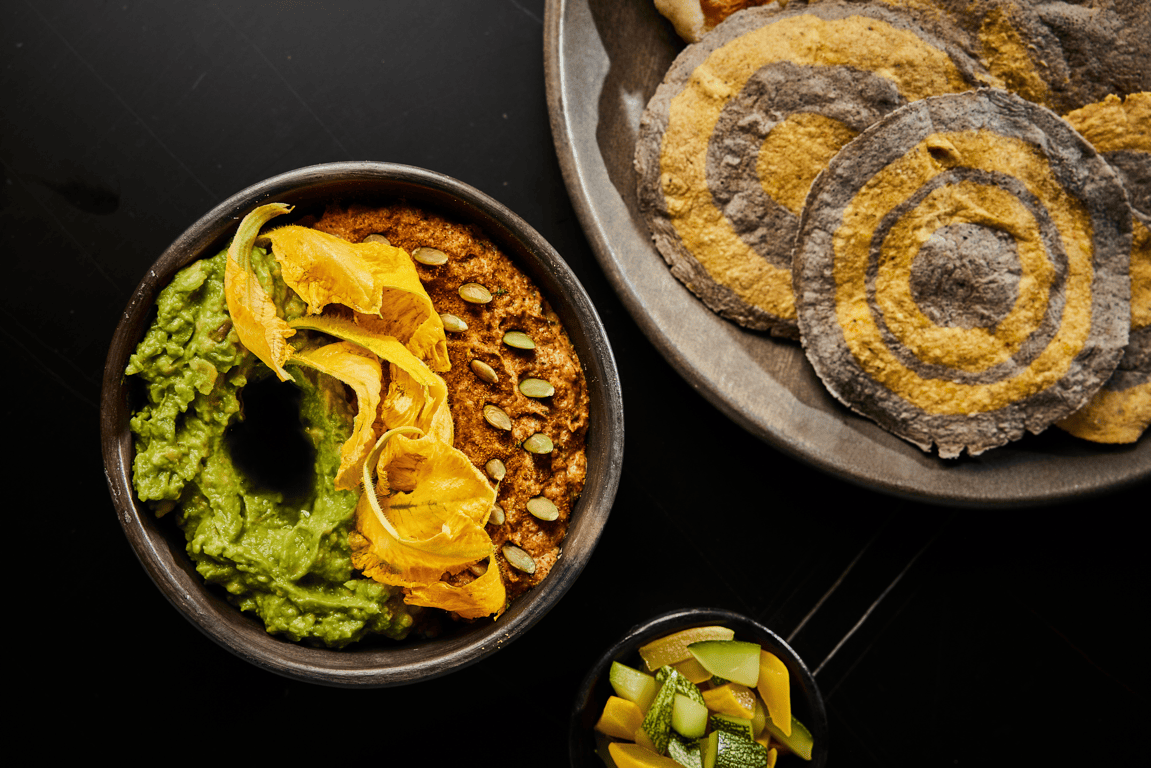
It’s All About the Tortilla
Craftsmanship, heritage and creativity mark the trend
It’s All About the Tortilla
Craftsmanship, heritage and creativity mark the trend
By Katie Ayoub
April 18, 2024
By Katie Ayoub
April 18, 2024
The inception of the tortilla dates back thousands of years to the Aztecs, who crafted the original version known as tlaxcalli. As a consequence of migration and exploration over the centuries, the flatbread, eventually renamed tortilla, gained much wider recognition while holding and deepening its status as a staple in Mexico and Central America. Both corn and flour varieties are tightly woven into the fabric of Mexican-inspired menus in American restaurants, moving from their position as a muted background player to star performer. Serious attention is being paid, especially to the corn tortilla, homing in on heirloom varietals, origin stories, artistic presentations and regional specialties that give the tortilla prominence.
“As a chef, I think there’s something so cool about elevating what’s been traditionally a fairly humble ingredient,” says Nate Weir, VP of culinary, Modern Market Eatery. “The tortilla is prime for innovation. It’s often treated as an afterthought or throwaway ingredient that simply serves as a carrier for the builds we’re focusing on. It’s exciting to see more discernment happening.” Indeed, the tortilla has long served as the carrier of many of today’s most craveable, beloved and on-trend menu items, from tacos and burritos to quesadillas and tostadas. Now, the opportunity centers around a mindful approach to all that a tortilla can bring to the table: texture, color, flavor, craftsmanship and story.
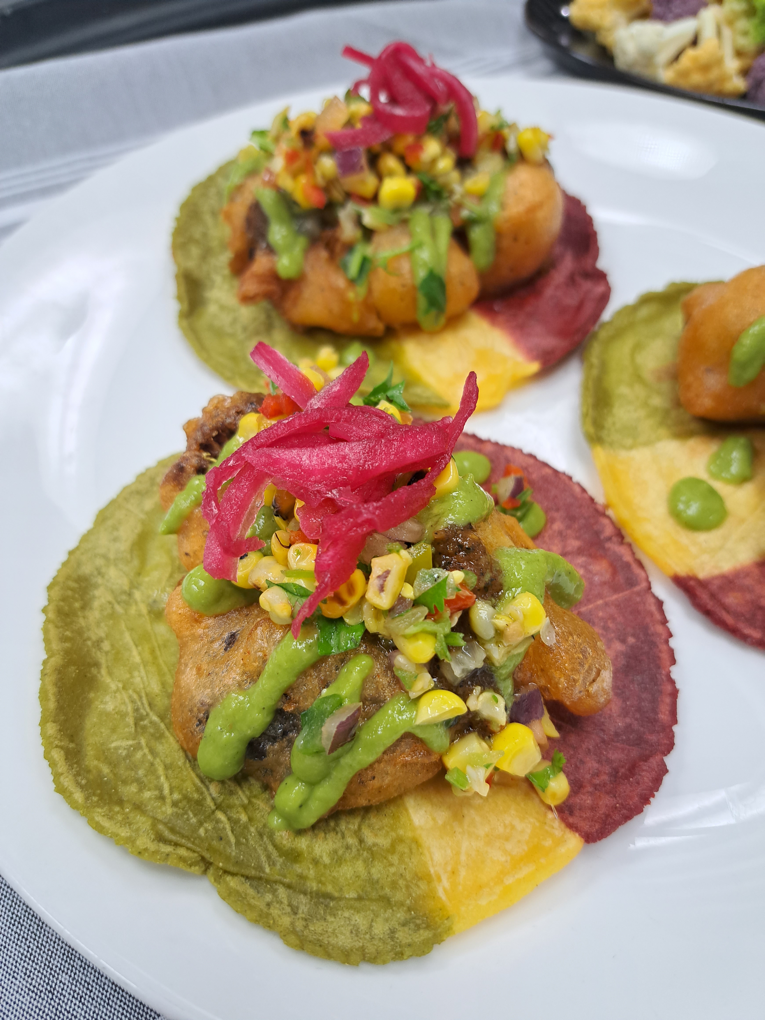 Photo Credit: Border Grill
Photo Credit: Border Grill Border Grill in Las Vegas employs nopales and cilantro to add color and flavor in its distinctive green tortillas.
All About the Masa
Masa is the Spanish word for dough, but in Mexico and Central America, it refers to the special dough prepared from stone-ground, nixtamalized corn. An ancient ingredient, masa is the superfood that serves as a building block for countless dishes, from the taco and arepa to the tetela and tlayuda. Now, more chefs in the U.S. are featuring the nixtamalization process and highlighting its specialness, giving momentum to the tortilla trend. Nixtamalizing (cooking field corn in a mixture of alkali and water before grinding) not only makes the nutrients in the corn more bioavailable, it softens the texture and develops flavor. When milled, the resulting masa yields exceptional corn tortillas.
DJ Flores, chef/owner of Milpa in Las Vegas, is a champion of traditional tortilla making. He and his kitchen staff prepare about 60 pounds of masa each morning, enough for 500 tortillas to fill both restaurant service and catering orders. Flores sources heirloom varietals of red, yellow and blue dried corn from small farms in Mexico. “Every varietal has a different starch level. The higher ones are good for tostadas and tlayudas. Lower ones are good for tabletop tortillas,” he says. “The beauty is in the natural colors and subtle flavors.” Flores is expanding his tortilla-making operation, opening a factory this year. “The demand from other restaurants—and consumers—is there. The sky’s the limit.”
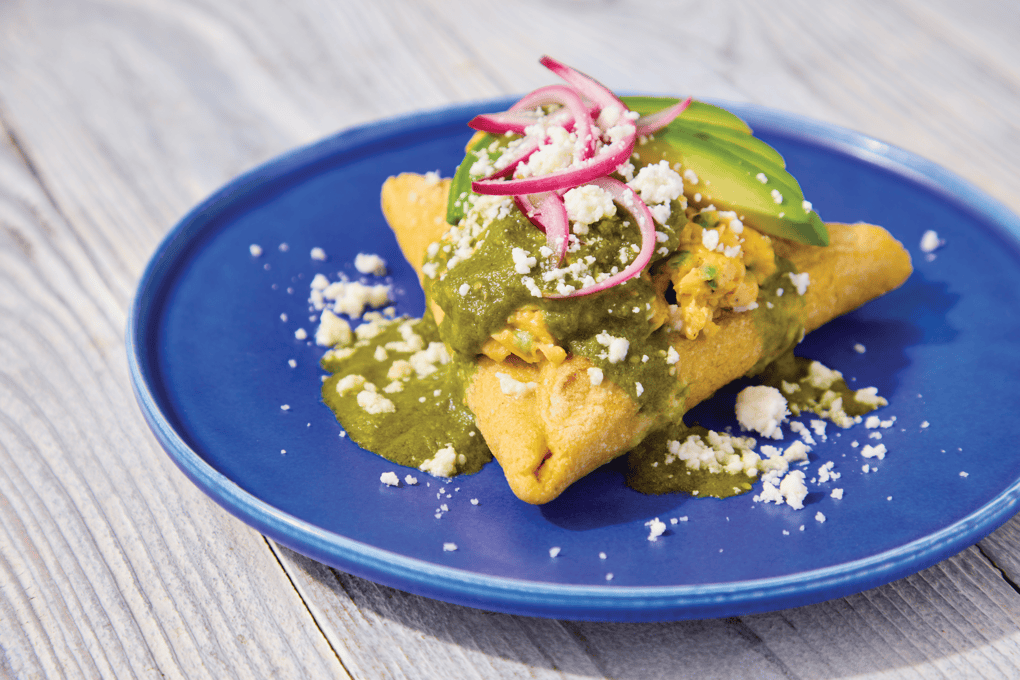 Photo Credit: California Milk Advisory Board
Photo Credit: California Milk Advisory Board The Black Bean Tetela & Two Eggs served at Milpa is topped with California queso fresco, pickled onions, jalapeños and salsa verde.
Jose Avila, chef/owner of La Diabla Pozole y Mezcal in Denver, also nixtamalizes whole dried corn from heirloom varietals in Mexico. The artisanal tortillas elevate his modern menu, providing a valued signature. His Street Taco Tuesday menu offers street-sized versions of the taco menu, from Huachinango with pineapple butter and citrus slaw to Tres Chorizos with cucumber and salsa verde. Brutø, also in Denver, boasts a 15-seat chef’s counter, serving an omakase-style tasting menu inspired by Latin cuisine. Michael Diaz De Leon, former chef/owner, calls out the heirloom variety used in one of Brutø’s dishes: The Cónico Azul Maíz Tostada features smoked heirloom yellow watermelon, pepita guacamole and pickled melon rind. Chicheria MX Kitchen in Atlanta dials up the specialness of its tortilla program by allowing guests to watch its team of skilled tortilleras demonstrate the process of hand-pressing the organic blue corn masa into tortillas. These are a highlight of the Smoked Maitake Mushroom Tacos, which also star poblano rajas, garlic crema and a crispy cheese “blanket.”
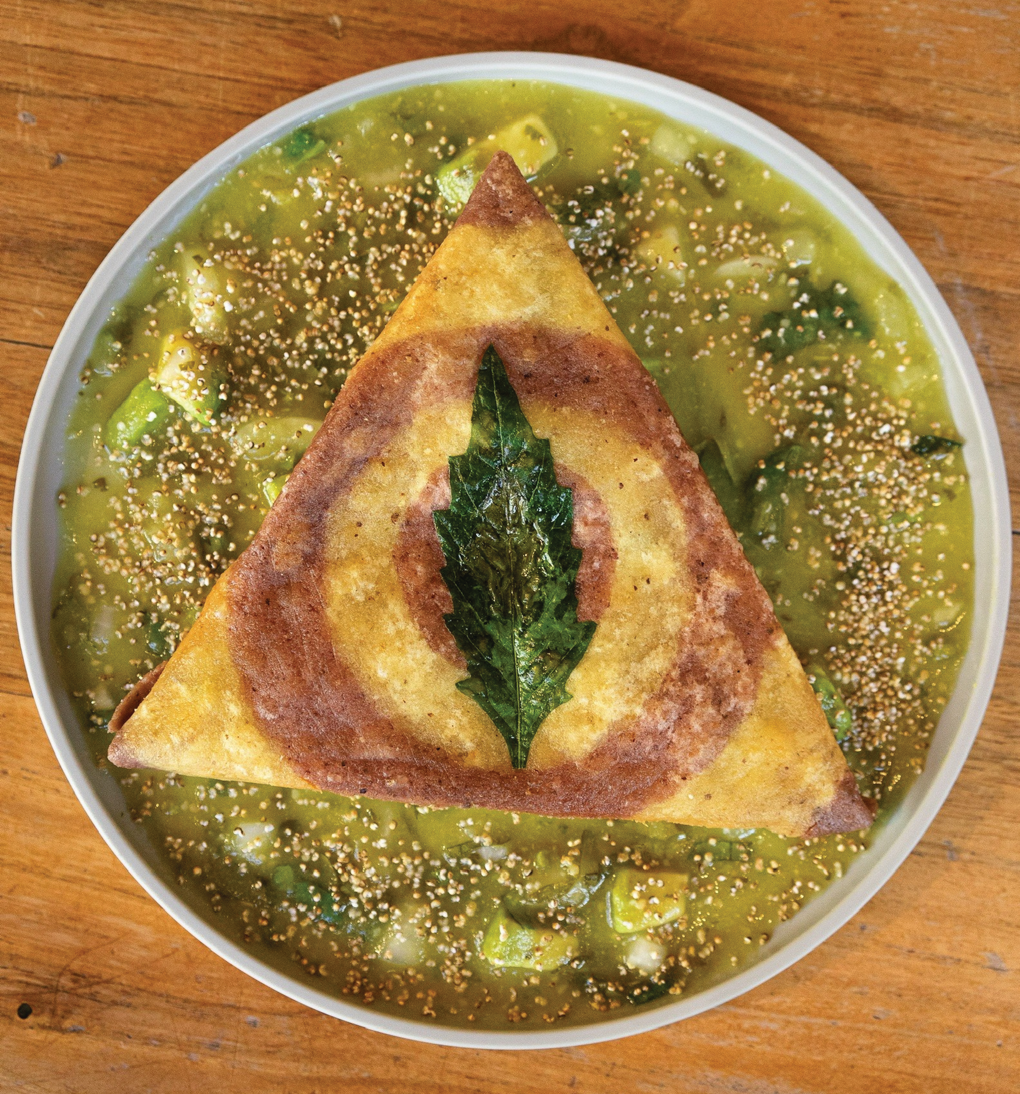 Photo Credit: Maiz de la Vida
Photo Credit: Maiz de la Vida Nashville’s Maíz de la Vida attracts attention with artisan tortillas, including its tetelas, featuring embossing and marbling techniques.
In Living Color
The tortilla’s rise into modern menu opportunity leans on several factors. Walking hand in hand with its origin story and authenticity is its visual impact. Of course, TikTok has helped froth up excitement here, pointing to ingenuity and beauty with viral videos that feature marble tortillas, swirling different colored varietals for a multi-hued result. Bacalar in Austin, Texas, seizes on this advantage by featuring tortillas made by mixing together different masas. Executive chef/partner Gabe Erales combines two varieties of heirloom red and yellow corn for select tortillas used at this Yucatán-inspired restaurant. “We blend them to showcase the beauty of landrace varietals. The visual appeal is compelling, as is the strong textural and flavor story of each varietal,” he says.
In Nashville, Maíz de la Vida makes artisan tortillas in-house, demonstrating how creative approaches can help differentiate the experience. One of the menu stars is the marbled nixtamal tortillas embossed with either hoja santa or epazote, lending a delightful Insta-worthy moment for the consumer.
Fruit infusions can lend unexpected color while deepening the flavor narrative. At Border Grill in Las Vegas, the Al Pastor Tacos stand out with pineapple juice-infused tortillas, while the Crispy Diablo Cauliflower Tacos sport tri-color ones made with beet juice (red), nopales and cilantro (green) and classic yellow corn. “We’re always trying to find a way to play off the main flavor combinations in the dish, looking for different ideas to enhance the flavor while making it stand out,” says John Baez, executive chef. “We’ve done squid ink tortillas to complement a lobster taco and huitlacoche tortillas for a Wagyu asada taco. We’re looking to do a fish taco with a mango infusion and something with jamaica [hibiscus], too.”
John Franke, president, Franke Culinary Consulting, affirms the value of using infusions to create signature tortillas. “The tremendous opportunity here is to invest the time and talent to make unique tortillas in-house,” he says, suggesting flavor/color combinations like beet and jalapeño, guajillo and cilantro, salsa verde and sesame-coconut.
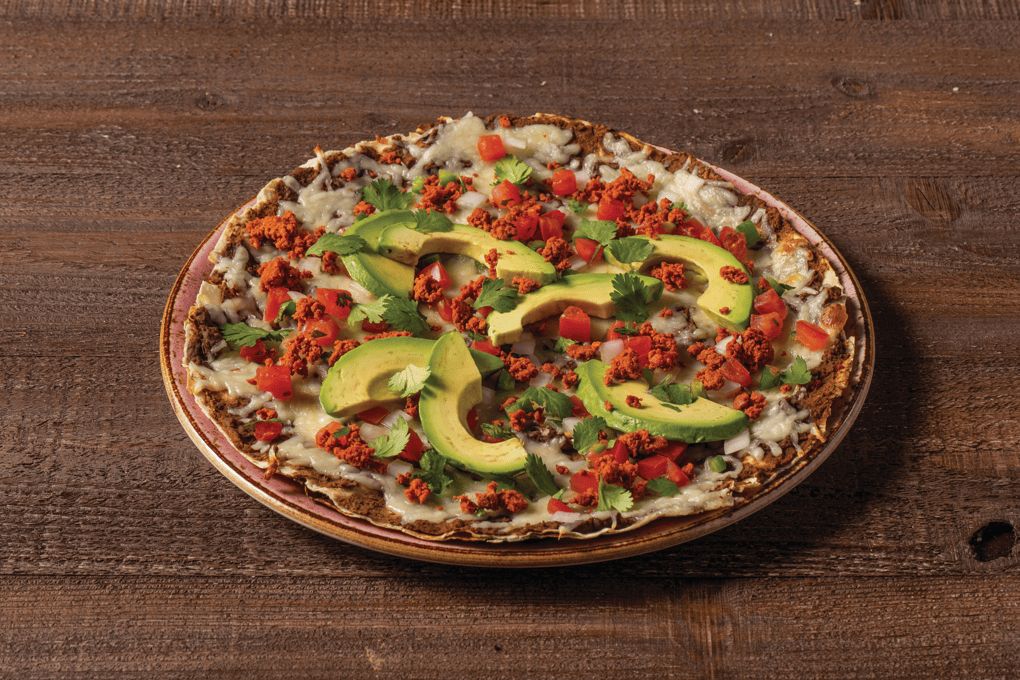 Photo Credit: Calaca Mamas
Photo Credit: Calaca Mamas Calaca Mamas Cantina in Anaheim, Calif., showcases how approachable the Oaxacan tlayuda is, topping a grilled flour tortilla with refried black beans, Oaxaca cheese, avocado, pico de gallo, crema and cilantro.
Oaxacan Wins
Digging into regional specialties unearths more opportunities that put the tortilla front and center. “As you start to see American consumers actually know Oaxacan food, it makes sense that interest in the tortilla goes up,” says Nikki Freihofer, strategy director, The Culinary Edge. “I think the opportunity is about all the things the tortilla can become, varying its size, shape and thickness. It’s stretching beyond the taco and quesadilla—that’s where we’re going to see the most traction.” Mexican cuisine is reliably fruitful for menu innovation, thanks to Americans’ unflagging affinity for it, she continues. “The tlayuda and tetela are inherently part of Mexican cuisine, but they’re a net-new format for most Americans.” Those formats are ripe with possibility.
The tetela, a triangular pocket made of masa, is similar to a quesadilla, but made with a raw tortilla. It’s stuffed with ingredients, folded into a triangle, then cooked on a comal. It’s popping up across the country, most notably as a breakfast item. At Milpa, Flores runs Black Bean Tetela & Two Eggs on his brunch menu. He makes the dish with heirloom yellow corn masa and a black bean filling. After cooking, he tops the tetela with cheesy scrambled eggs and a sprinkling of California queso fresco. “I wanted to bring the tetela from Mexico,” he says. “It’s become a sleeper hit on our menu.”
The tlayuda, Mexico’s version of a thin-crust pizza, shows up on the brunch menu at Dove’s Luncheonette, a Tex-Mex diner in Chicago. Described as a “giant corn tortilla,” it’s topped with refried black beans, Jack cheese, roasted squash, arugula and cranberry salsa roja. Tierra del Sol in Portland, Ore., serves its Tlayuda on the lunch and dinner menu, topping it with asiento (chicharrón bits), black beans, queso Oaxaca, cabbage, tomatoes, red onion, radish, queso fresco, cilantro and avocado. At For All Things Good in New York, the Breakfast Tlayudita sports a crackling tortilla topped with beans, melted cheese, avocado, chile oil and a runny egg.
“The tortilla is such an important part of Mexican cuisine, and it’s just now coming into the spotlight,” says Baez. “Your diners are still going to be interested in the stuffings and fillings, but now they’re paying more attention to the wrap part of the experience. It’s great to give them creative options.”
The inception of the tortilla dates back thousands of years to the Aztecs, who crafted the original version known as tlaxcalli. As a consequence of migration and exploration over the centuries, the flatbread, eventually renamed tortilla, gained much wider recognition while holding and deepening its status as a staple in Mexico and Central America. Both corn and flour varieties are tightly woven into the fabric of Mexican-inspired menus in American restaurants, moving from their position as a muted background player to star performer. Serious attention is being paid, especially to the corn tortilla, homing in on heirloom varietals, origin stories, artistic presentations and regional specialties that give the tortilla prominence.
“As a chef, I think there’s something so cool about elevating what’s been traditionally a fairly humble ingredient,” says Nate Weir, VP of culinary, Modern Market Eatery. “The tortilla is prime for innovation. It’s often treated as an afterthought or throwaway ingredient that simply serves as a carrier for the builds we’re focusing on. It’s exciting to see more discernment happening.” Indeed, the tortilla has long served as the carrier of many of today’s most craveable, beloved and on-trend menu items, from tacos and burritos to quesadillas and tostadas. Now, the opportunity centers around a mindful approach to all that a tortilla can bring to the table: texture, color, flavor, craftsmanship and story.
 Photo Credit: Border Grill
Photo Credit: Border Grill Border Grill in Las Vegas employs nopales and cilantro to add color and flavor in its distinctive green tortillas.
All About the Masa
Masa is the Spanish word for dough, but in Mexico and Central America, it refers to the special dough prepared from stone-ground, nixtamalized corn. An ancient ingredient, masa is the superfood that serves as a building block for countless dishes, from the taco and arepa to the tetela and tlayuda. Now, more chefs in the U.S. are featuring the nixtamalization process and highlighting its specialness, giving momentum to the tortilla trend. Nixtamalizing (cooking field corn in a mixture of alkali and water before grinding) not only makes the nutrients in the corn more bioavailable, it softens the texture and develops flavor. When milled, the resulting masa yields exceptional corn tortillas.
DJ Flores, chef/owner of Milpa in Las Vegas, is a champion of traditional tortilla making. He and his kitchen staff prepare about 60 pounds of masa each morning, enough for 500 tortillas to fill both restaurant service and catering orders. Flores sources heirloom varietals of red, yellow and blue dried corn from small farms in Mexico. “Every varietal has a different starch level. The higher ones are good for tostadas and tlayudas. Lower ones are good for tabletop tortillas,” he says. “The beauty is in the natural colors and subtle flavors.” Flores is expanding his tortilla-making operation, opening a factory this year. “The demand from other restaurants—and consumers—is there. The sky’s the limit.”
 Photo Credit: California Milk Advisory Board
Photo Credit: California Milk Advisory Board The Black Bean Tetela & Two Eggs served at Milpa is topped with California queso fresco, pickled onions, jalapeños and salsa verde.
Jose Avila, chef/owner of La Diabla Pozole y Mezcal in Denver, also nixtamalizes whole dried corn from heirloom varietals in Mexico. The artisanal tortillas elevate his modern menu, providing a valued signature. His Street Taco Tuesday menu offers street-sized versions of the taco menu, from Huachinango with pineapple butter and citrus slaw to Tres Chorizos with cucumber and salsa verde. Brutø, also in Denver, boasts a 15-seat chef’s counter, serving an omakase-style tasting menu inspired by Latin cuisine. Michael Diaz De Leon, former chef/owner, calls out the heirloom variety used in one of Brutø’s dishes: The Cónico Azul Maíz Tostada features smoked heirloom yellow watermelon, pepita guacamole and pickled melon rind. Chicheria MX Kitchen in Atlanta dials up the specialness of its tortilla program by allowing guests to watch its team of skilled tortilleras demonstrate the process of hand-pressing the organic blue corn masa into tortillas. These are a highlight of the Smoked Maitake Mushroom Tacos, which also star poblano rajas, garlic crema and a crispy cheese “blanket.”
 Photo Credit: Maiz de la Vida
Photo Credit: Maiz de la Vida Nashville’s Maíz de la Vida attracts attention with artisan tortillas, including its tetelas, featuring embossing and marbling techniques.
In Living Color
The tortilla’s rise into modern menu opportunity leans on several factors. Walking hand in hand with its origin story and authenticity is its visual impact. Of course, TikTok has helped froth up excitement here, pointing to ingenuity and beauty with viral videos that feature marble tortillas, swirling different colored varietals for a multi-hued result. Bacalar in Austin, Texas, seizes on this advantage by featuring tortillas made by mixing together different masas. Executive chef/partner Gabe Erales combines two varieties of heirloom red and yellow corn for select tortillas used at this Yucatán-inspired restaurant. “We blend them to showcase the beauty of landrace varietals. The visual appeal is compelling, as is the strong textural and flavor story of each varietal,” he says.
In Nashville, Maíz de la Vida makes artisan tortillas in-house, demonstrating how creative approaches can help differentiate the experience. One of the menu stars is the marbled nixtamal tortillas embossed with either hoja santa or epazote, lending a delightful Insta-worthy moment for the consumer.
Fruit infusions can lend unexpected color while deepening the flavor narrative. At Border Grill in Las Vegas, the Al Pastor Tacos stand out with pineapple juice-infused tortillas, while the Crispy Diablo Cauliflower Tacos sport tri-color ones made with beet juice (red), nopales and cilantro (green) and classic yellow corn. “We’re always trying to find a way to play off the main flavor combinations in the dish, looking for different ideas to enhance the flavor while making it stand out,” says John Baez, executive chef. “We’ve done squid ink tortillas to complement a lobster taco and huitlacoche tortillas for a Wagyu asada taco. We’re looking to do a fish taco with a mango infusion and something with jamaica [hibiscus], too.”
John Franke, president, Franke Culinary Consulting, affirms the value of using infusions to create signature tortillas. “The tremendous opportunity here is to invest the time and talent to make unique tortillas in-house,” he says, suggesting flavor/color combinations like beet and jalapeño, guajillo and cilantro, salsa verde and sesame-coconut.
 Photo Credit: Calaca Mamas
Photo Credit: Calaca Mamas Calaca Mamas Cantina in Anaheim, Calif., showcases how approachable the Oaxacan tlayuda is, topping a grilled flour tortilla with refried black beans, Oaxaca cheese, avocado, pico de gallo, crema and cilantro.
Oaxacan Wins
Digging into regional specialties unearths more opportunities that put the tortilla front and center. “As you start to see American consumers actually know Oaxacan food, it makes sense that interest in the tortilla goes up,” says Nikki Freihofer, strategy director, The Culinary Edge. “I think the opportunity is about all the things the tortilla can become, varying its size, shape and thickness. It’s stretching beyond the taco and quesadilla—that’s where we’re going to see the most traction.” Mexican cuisine is reliably fruitful for menu innovation, thanks to Americans’ unflagging affinity for it, she continues. “The tlayuda and tetela are inherently part of Mexican cuisine, but they’re a net-new format for most Americans.” Those formats are ripe with possibility.
The tetela, a triangular pocket made of masa, is similar to a quesadilla, but made with a raw tortilla. It’s stuffed with ingredients, folded into a triangle, then cooked on a comal. It’s popping up across the country, most notably as a breakfast item. At Milpa, Flores runs Black Bean Tetela & Two Eggs on his brunch menu. He makes the dish with heirloom yellow corn masa and a black bean filling. After cooking, he tops the tetela with cheesy scrambled eggs and a sprinkling of California queso fresco. “I wanted to bring the tetela from Mexico,” he says. “It’s become a sleeper hit on our menu.”
The tlayuda, Mexico’s version of a thin-crust pizza, shows up on the brunch menu at Dove’s Luncheonette, a Tex-Mex diner in Chicago. Described as a “giant corn tortilla,” it’s topped with refried black beans, Jack cheese, roasted squash, arugula and cranberry salsa roja. Tierra del Sol in Portland, Ore., serves its Tlayuda on the lunch and dinner menu, topping it with asiento (chicharrón bits), black beans, queso Oaxaca, cabbage, tomatoes, red onion, radish, queso fresco, cilantro and avocado. At For All Things Good in New York, the Breakfast Tlayudita sports a crackling tortilla topped with beans, melted cheese, avocado, chile oil and a runny egg.
“The tortilla is such an important part of Mexican cuisine, and it’s just now coming into the spotlight,” says Baez. “Your diners are still going to be interested in the stuffings and fillings, but now they’re paying more attention to the wrap part of the experience. It’s great to give them creative options.”
About the Author
![]() Katie Ayoub serves as managing editor of Flavor & The Menu and content strategist for the Flavor Experience, an annual conference geared toward chain operators. She is president of Katie Ayoub & Associates, serving up menu trends expertise, content creation and food & beverage consultancy. Based in Chicago, Katie has been working in foodservice publishing for more than 20 years and part of the Flavor team since 2006. [email protected]
Katie Ayoub serves as managing editor of Flavor & The Menu and content strategist for the Flavor Experience, an annual conference geared toward chain operators. She is president of Katie Ayoub & Associates, serving up menu trends expertise, content creation and food & beverage consultancy. Based in Chicago, Katie has been working in foodservice publishing for more than 20 years and part of the Flavor team since 2006. [email protected]







